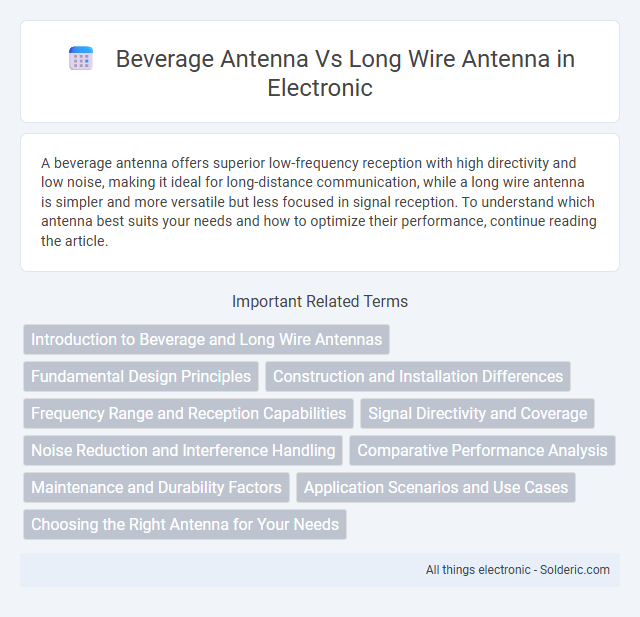A beverage antenna offers superior low-frequency reception with high directivity and low noise, making it ideal for long-distance communication, while a long wire antenna is simpler and more versatile but less focused in signal reception. To understand which antenna best suits your needs and how to optimize their performance, continue reading the article.
Comparison Table
| Feature | Beverage Antenna | Long Wire Antenna |
|---|---|---|
| Design | Low-height, directional receiving antenna | Simple long wire, non-directional or less directional |
| Primary Use | Low-frequency (LF, MF, HF) reception with high directivity | Transmission and reception across HF bands |
| Length | Typically hundreds of feet, several wavelengths | Variable length, typically 20 to 100 feet |
| Radiation Pattern | Highly directional, cardioid pattern | Omnidirectional to moderately directional |
| Gain | Moderate to high gain for reception | Moderate gain, better for transmission |
| Installation | Requires ground system, physical wire stretch, low mounting height | Simple installation, elevated wire preferred |
| Suitability | Best for noise reduction in noisy environments | Versatile, suitable for general amateur radio use |
| Impedance | Typically low impedance, needs matching transformer | Varies, often matched via antenna tuner |
Introduction to Beverage and Long Wire Antennas
Beverage antennas are long-wire receiving antennas typically used for low-frequency and medium-frequency bands, renowned for their excellent directionality and low noise reception. Long wire antennas are versatile transmitting and receiving antennas characterized by lengths of at least one wavelength, providing broad bandwidth and simple design. Both antenna types rely on elongated wire elements but differ in installation orientation and primary application focus.
Fundamental Design Principles
Beverage antennas are characterized by their long, low, and horizontally stretched wire design, optimized for receiving low-frequency signals with high directivity and low noise, typically installed close to the ground. Long wire antennas consist of a single extended conductor, often elevated and oriented to maximize signal reception or transmission over a broad frequency range but with less inherent directionality compared to Beverage antennas. Understanding these fundamental design principles helps you select the appropriate antenna type based on your specific radio communication needs and environmental conditions.
Construction and Installation Differences
A Beverage antenna features a long, low wire typically installed close to the ground with support poles, designed for directional reception and requiring careful orientation toward signal sources. In contrast, a Long Wire antenna is generally a simpler single-wire setup suspended high in the air without strict directional alignment, allowing for broader coverage but less selectivity. Your choice depends on installation space, desired directionality, and ease of setup, with Beverage antennas demanding more precise construction and positioning.
Frequency Range and Reception Capabilities
Beverage antennas excel at low-frequency ranges, typically from 10 kHz to 30 MHz, providing highly directional reception ideal for long-distance, low-noise signal capture. Long wire antennas operate over a broader frequency spectrum, commonly from 1 MHz up to 30 MHz, offering less directionality but improved versatility for general HF band reception. For your needs, choosing between a Beverage or long wire antenna depends on prioritizing either enhanced low-frequency performance with minimal noise or broader frequency coverage with flexible reception capabilities.
Signal Directivity and Coverage
Beverage antennas provide superior signal directivity by focusing reception along a narrow, low-angle beam, which enhances long-distance communication and reduces noise from unwanted directions. Long wire antennas offer broader coverage with less directional sensitivity, capturing signals from multiple angles but with increased susceptibility to interference. Your choice depends on whether precise signal targeting or wide-area reception better suits your communication needs.
Noise Reduction and Interference Handling
Beverage antennas excel in noise reduction due to their low-angle reception and directional properties, which minimize interference from local noise sources and unwanted signals. Long wire antennas, while simpler and broader in frequency response, tend to pick up more ambient noise and interference because of their less directional nature. For improved signal clarity in noisy environments, Beverage antennas provide superior performance by effectively rejecting ground and atmospheric noise.
Comparative Performance Analysis
Beverage antennas exhibit superior low-angle reception and enhanced signal-to-noise ratio compared to long wire antennas, making them ideal for long-distance HF communications. Long wire antennas offer broader bandwidth and easier installation but typically suffer from higher noise levels and less directional gain. The directional characteristics of Beverage antennas provide better selectivity and reduced interference, resulting in improved performance for weak signal reception over extended distances.
Maintenance and Durability Factors
Beverage antennas generally require more maintenance due to their length and ground installation, which exposes them to environmental wear like moisture and vegetation growth. Long wire antennas tend to be more durable and easier to maintain, as their simpler design and elevated positioning reduce exposure to ground-level damage. Your choice should consider the available space and willingness to perform regular upkeep for optimal antenna longevity.
Application Scenarios and Use Cases
Beverage antennas excel in low-frequency, long-distance communications such as amateur radio DXing and HF reception due to their high gain and directional properties. Long wire antennas offer versatility for general-purpose HF and VHF communication, favored in limited-space setups and portable field operations. Beverage antennas are ideal for fixed installations targeting weak signal reception over hundreds of miles, while long wire antennas suit broader frequency coverage and simpler deployment.
Choosing the Right Antenna for Your Needs
Selecting between a Beverage antenna and a long wire antenna depends on your specific communication goals and environment. The Beverage antenna excels in low-noise, long-distance reception on HF bands, making it ideal for DX listening and contests, while a long wire antenna offers a simpler, more versatile setup for general shortwave or local communication. Your choice should consider available space, desired frequency range, and performance requirements to ensure optimal signal clarity and transmission efficiency.
beverage antenna vs long wire antenna Infographic

 solderic.com
solderic.com